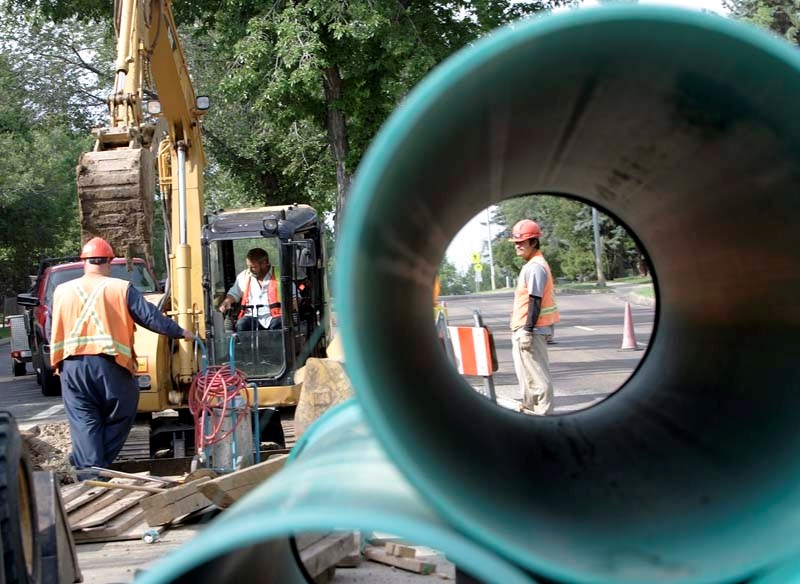Deciding how the city will fund the construction of future facilities like water reservoirs and pumphouses begins next week as city councillors begin deliberating on a utility fiscal policy.
The process will begin Monday when councillors, sitting as the standing committee on finance, will get a review of recommendations that a hired consultant first presented in February 2013. Last spring, council postponed a decision on the complex issue until this winter, allowing the newly-elected council to make the decision.
Monday’s meeting will be the first finance committee session in 2014 to devote time to the utility fiscal policy, which is expected to be discussed in March and April as well.
Utility rates that city residents pay became a hot-button topic during last fall’s election.
City staffers currently have no overarching policy to guide them so they rely on a combination of legislation like the Municipal Government Act and the city’s past practices, said Ashleigh Campbell, utility and accounts receivable controller for the city.
“We’re missing something concrete in place to guide us,” she said.
What is in place is the city policy on debt, which says “long-term debt shall not be considered for growth-related or ‘strategic’ utility servicing purchases.”
Debt can be considered for the rehabilitation of existing or the construction of major utility infrastructure.
According to a discussion paper from the city on utilities, this can make it challenging to maintain rate stability since it means funds have to be built up ahead of time to pay for a big utility project.
The desired utility fiscal policy would include a rate model but would be broader than just rates.
The city’s current utility rate model is often called the “100-year model.”
This model can forecast rates up to 100 years into the future but it doesn’t necessarily mean it can fund all projects within that time frame, Campbell said.
She said the city works off a 10-year capital plan.
The model is about forecasting rates and the operating costs, and doesn’t include amortization, said Brenda Barclay, financial operations and reporting manager for the city.
Perhaps a clearer description of how the current model operates is what Campbell calls a “cash-needs basis.”
Under this model, projections of future capital expenditures and operating costs are used to determine rates. Those rates are intended to ensure the city’s utility reserve accounts never fall below zero.
That model is now predicting that some of the upcoming needs won’t be met, so a consultant was hired to review it and suggest changes, which they presented last year.
“I think the model right now is predicting that we go into a deficit (in the four utility reserve funds)… in 2018,” Campbell said.
A 6.5 per cent rate increase was passed for both 2013 and 2014. In 2008, the utility rate model predicted increases of 9.5 per cent a year for the next 10 years.
Barclay noted St. Albert is both growing and has some aging infrastructure.
Barclay noted a policy being developed would give staff some direction from council.
Recommendations from the consultants presented last year included not using grant funding for capital projects, taking on debt for some projects and using debt-financing to front-end growth related capital projects.
Council will have to consider a number of these issues as they begin deliberating on the direction a policy should take. Should debt be used for more than just repair and maintenance? Should grant money be used for utility capital projects, leaving the city possibly holding the bag if a grant program is discontinued? Should all the projects in the capital plan be funded, instead of listing some as unfunded?
Mel McMillan, a University of Alberta emeritus professor of economics, said there are many different utility models but said it is hard to add substantial amounts of infrastructure with a no-debt policy.
“Pay-as-you-go is not unreasonable if you’re adding relatively small amounts or replacing relatively small amounts of infrastructure at any one time, but if you’re talking about a big chunk it’s sort of like buying a house as opposed to buying a refrigerator,” McMillan said.
Saving up ahead of time for big capital infrastructure projects can be tough.
“It’s sometimes a difficult thing to do because taxpayers are always interested in lower taxes,” he said.
But borrowing can also be expensive, depending on the interest rates. Right now interest rates are low so taking on debt isn’t as expensive, he said.
Edmonton previously tried not to borrow and pay down its debt, McMillan said.
But in the last 10 years, growth made it difficult to keep up with capital projects while using a no-debt policy.
“When you get into things like LRTs, for example, which is pretty expensive and a lot of up-front capital, that became pretty difficult,” he said.




